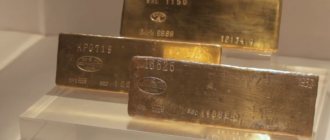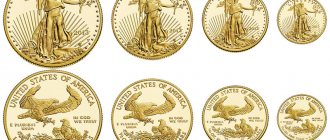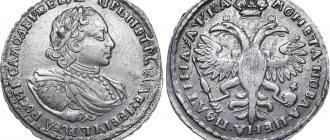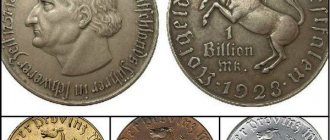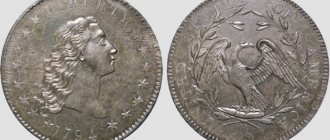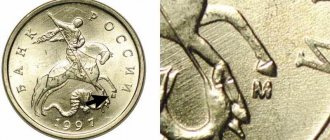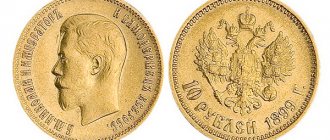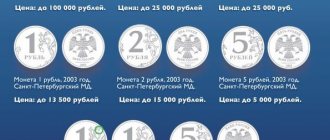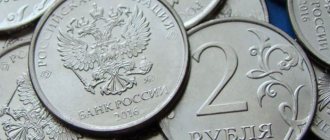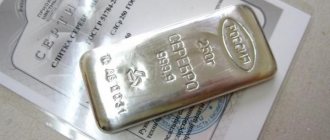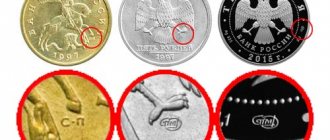Russia is a vast country with a long, long history. Russia is a country that defeated Napoleon and fascism. A country that has gone through many wars and almost always emerged victorious. The country that gave us Pushkin, Tchaikovsky, Lermontov, Tyutchev, and other famous writers and playwrights. The country of exploits and the birthplace of famous commanders. The history of Russia is truly captivating, from the princes to the exploits of the marshals of the Second World War, it makes you imbued with the Russian spirit.
But the entire history of Russia is accompanied by money, which has also undergone changes over time, just like our country. The history of coins also deserves its place in our history. Unfortunately, this is not given enough attention. Therefore, in this article you will learn about the most famous coins of our country, which were minted back in the 18th century.
A copper coin with the image of St. George the Victorious began to be minted in 1757. The Russian Empire, having entered the Seven Years' War in 1756, needed an infusion of considerable funds. It was then, during the reign of the Russian Empress Elizabeth I, that it was decided to double the issuer of the copper coin stack.
At the same time, the nominal value of copper coins was approved (coins in denominations of one, two and five kopecks) and their design was changed, in particular, on 1 and 2 kopecks.
Coin with the image of St. George the Victorious, 1757, with a denomination of two kopecks
Description of the coin and types of mintage
Obverse of the coin: in the center is the monogram of Empress Elizaveta Petrovna (the intertwining of the letters “E” (Elisabetha) and “P” (Petrovna) in a mirror image), near the left and right edges is the year of minting, the imperial crown rises above. The monogram is surrounded by an open wreath of laurel and palm branches, united on the lower fragment by a ribbon in the form of a bow.
Reverse of the coin: in the central part there is a silhouette of St. George the Victorious, the Holy Great Martyr. He is represented on horseback, defeating a winged serpent with a spear. At the bottom there is a tape where the face value of the coin is written. There are two-kopeck coppers from 1757, where the ribbon with the nominal value is placed above St. George the Victorious. The minting of coins in denominations of 2 kopecks with the image of St. George the Victorious was carried out from 1757 to 1767.
Watch the video: illustration of a 2 kopeck coin from 1757 with the image of St. George the Victorious.
Two kopecks are characterized by a large number of types and re-coins that appeared during the Seven Years' War, in the course of re-coining from other coins and minting on even circles (re-coins). Re-minting was carried out from a coin of one kopeck from 1754 - 1757 (cloud), produced in the capital and Yekaterinburg (coins with a mesh edge were minted without re-minting), five kopecks from 1722 - 1730 (cross) and 2 era 1743 (Sweden). If the finish was of poor quality, the coin might have an imprint of a Swedish coin.
Mints
Coins were produced in Russia at several yards:
- at the Moscow Mint (MMD, Red Mint);
- at the Yekaterinburg Mint (EMD);
- at the St. Petersburg Mint (SPMD);
- at the Sestroretsk Mint (SMD).
We advise you to watch: the history of Russian mints.
Summarized material on different types of coins is given in the table below. The differences for SPMD and SMD have the same characteristics, since stamps were not produced in Sestroretsk, but St. Petersburg stamps were used.
| Mint | Characteristic features |
| edge | |
| MMD | In 1757 - the denomination is at the top, the edge is with a large mesh, the circle is thin and of increased diameter (re-coined). In 1757-1760 – the denomination at the bottom, with a thin circle of increased diameter, edges with a large mesh (re-coined from the crosses) and the inscriptions MMD and the Yekaterinburg Court (re-coined from the clouds). For a thick mug of small diameter, the edge is either with a coarse mesh or smooth. |
| EMD | 1757-1762 – the denomination at the bottom, with a thin circle of increased diameter, edges with a large mesh (re-coined from the crosses) and the inscriptions MMD and the Yekaterinburg Court (re-coined from the clouds). For a thick mug of small diameter, the edge is with a fine mesh, smooth, or with an inscription (1957) 1757-1760 - denomination at the top, edge with a fine mesh or the inscription of the Yekaterinburg Court. |
| SPMD | 1757 – denomination at the top, with a thin circle of increased diameter, an edge with a coarse mesh (re-coined from the cross coins). 1757 -1759 – the denomination at the bottom, with a thin circle of increased diameter, edges with a large mesh (re-coined from the crosses) and the inscriptions MMD and the Yekaterinburg Court (re-coined from the clouds). |
| SMD | 1757-1758 – denomination at the bottom, edges with a large mesh (re-coinage of the Swedish era). |
| Crown | |
| MMD | 1757-1758 – narrow crown, the stone is located at the level of the crown cut. 1757-1760 – a wide crown with a protruding rim and a depressed stone. There is a variety with 4 stones along the rim. |
| SPMD (SMD) | 1757 – narrow crown with a stone above the cut of the crown, 3 stones along the rim. 1757-1759 – wide crown, stone at the level of the crown cut, 5 stones along the rim. |
| EMD | The stone is slightly below the crown cut. |
| Top left petal on a branch | |
| MMD | The petal is obtuse, with a notch at the bottom. There are coins from 1757 where the petal is directed to the side. |
| SPMD (SMD) | The petal is sharp, with a notch at the bottom. |
| EMD | The petal at the bottom is without a notch. |
| Monogram | |
| MMD | The number “1” is close to the berry on the branch of the wreath. Reduced distance between monogram curls, so that the numbers “do not go through” (in most cases). 1757-1758 – lower curls overlap to the right. 1757-1760 – lower curls with an overlap to the left. |
| SPMD (SMD) EMD | The number “1” is removed from the berry on the wreath branch. Increased distance between the curls of the monogram, so that the numbers “go through”. The lower curls only overlap to the left. |
| Number "1" | |
| MMD | The top is slightly inclined, the bottom is jackdaw-shaped with a curved right edge. |
| SPMD (SMD) | The top has a large slope, the bottom is jackdaw-shaped without bending the right edge. |
| EMD | The top is horizontal, the bottom is jackdaw-shaped with an elongated bend on the left edge. |
| Number "7" | |
| MMD | The vertical line of the seven has straight lines with a rounded lower tail. |
| SPMD (SMD) | Straight bevel on the top left edge. |
| EMD | The vertical line of the seven has rounded lines with a lower tail without rounding. |
| Number "5" | |
| MMD | 1757 – tail rounded upward; with a horizontal tail there is a large lower bend. 1758 - rounded horizontal tail with a large lower protrusion. |
| SPMD (SMD) | Horizontal tail with a large lower bend. |
| EMD | 1757 – the tail is directed upward, there is a large protrusion of a vertical line; 1758-59 – straight short upper tail, vertical line with a slope. |
| Number "8" | |
| MMD | Figure eight with an overlap to the right. |
| SPMD (SMD) EMD | The figure eight consists of two connected rings. |
| Horse | |
| MMD | The snaffle is located between the head and neck. The bend line of the front leg runs along the medallion. The forearm is narrow (1757) and wide (1757-1760). The slope of the tail is gentle, the croup is flat (1757-58), the croup is convex (1757-60). |
| SPMD (SMD) | The snaffle is located between the head and neck. The bend line of the front leg passes above the medallion. The forearm is narrow. The end of the tail is steeply sloping, the tip of the tail is sharp. |
| EMD | The snaffle is located on the neck. The bend line of the front leg passes above the medallion. Medallion in the form of a ring. The slope of the tail is gentle. |
| Rider | |
| MMD | Landing with tilt (1757), without tilt (1757-60). Left fist with fingers. On a spear, the palm is turned sideways (1757), the palm is turned up (1757-60). There is a cross on the saddle, but there are coins from 1757 without the cross. |
| SPMD (SMD) | Tilt landing. Left fist without fingers. On a spear, the palm is turned sideways. There is a cross on the saddle. |
| EMD | The difference from the SPD is that the spear has a knob. |
To more accurately determine at which mint a coin was minted, you need to use a combination of distinctive features.
Many of these features vary in appearance due to the large number of mintages and coinage technology. Stamps often became unusable, and new ones had to be made or old ones repaired.
Coins with military fittings
During the Seven Years' War, in the design of coins from 1761, they began to depict “military fittings,” i.e., elements of a military theme that made up an integral composition.
On a coin of 2 kopecks, under the denomination in the form of the number “2”, the inscription “Two kopecks” and the year of issue, fittings were minted, representing a drum, a cannon, spears and banners. On the back of the coin was depicted St. George the Victorious, defeating a winged dragon with a spear, but already standing on the ground. In addition, two stars were minted to the left and right of the horse.
Coin two kopecks with the image of St. George the Victorious
The coins were minted as proof coins at the St. Petersburg Mint. After the death of Elizabeth Petrovna, Tsar Peter III put them into circulation without changing the design (with military fittings).
Appearance of a four-kopeck coin with the image of St. George the Victorious
Georgy, Yuri, Egory Brave
The veneration of the Holy Great Martyr George in the Russian lands was established almost immediately after the adoption of Christianity. The son of the baptizer of Rus', Prince Yaroslav the Wise, took the name of this saint at baptism. In honor of his heavenly patron, in the 30s of the 11th century, the prince founded two monasteries - in Kyiv and Veliky Novgorod. The latter has survived to this day. In memory of this, two holidays appeared in Rus': Yegoriy Veshny (May 23, Old Style) and Yegoriy Osenniy (November 26, Old Style).
The first was especially revered by shepherds, cattle breeders and herdsmen. St. George was considered the patron saint of domestic animals, a protector from wolves and poisonous snakes.
The second holiday is better known to us as St. George's Day. The same one in which peasants were allowed to move from one master to another. However, guarding livestock was not the most important “work” of St. George. Patronage of soldiers and defense of the faith of Christ was considered much more significant.
The spiritual verse of the first half of the 16th century sets out the plot of the confrontation between Yegory (George) the Brave and the “basurman king Demyanishch.” In essence, this is a free presentation of the canonical life of the saint in the epic style. Demyanishche (Emperor Diocletian), captures Yegor and throws him into prison for 30 years. The Mother of God helps the warrior to free himself. He returns to his homeland, wins Demyanishche in a duel and saves Rus' from infidelity. For several hundred years, this story fed many fair singers and actors. And this is not surprising. The acts of St. are very similar. Egoria on the adventures of Ilya Muromets. And we love heroes.
And yet the most striking achievement of the saint was the fight with the dragon. The story of how George defeated the winged serpent that was rampaging near Beirut and saved the daughter of the local king from its gastronomic claims inspired more than one generation of glorious knights to heroic deeds. Moreover, not only in Rus', but also in Asia and, of course, in Europe.
The image of the righteous knight-snake fighter very soon became a popular heraldic image and was firmly established on the coats of arms and banners of noble warriors. And then he confidently migrated to numismatics.
Coin value
For a 1757 coin with St. George the Victorious, the price on the numismat markets of the Russian Federation varies greatly, as it depends on the condition of the coin, its type, and the presence of defects. The approximate price ranges from 6 to 61 thousand rubles.
For example, for a coin in Fine condition from the Yekaterinburg Mint you can get about 200 rubles. The cost of two kopecks in VF (Very Fine) condition is 600 - 3 thousand rubles, EF (Extremely Fine) - over 6 thousand rubles, AU (About Uncirculated) - approximately 20 thousand rubles. For a coin that has not been circulated in circulation, you can get about 50 thousand rubles.
We recommend watching the video: the most expensive and rare coins of Elizabeth Petrovna.
Copper 2 kopecks from 1757-1762 are considered one of the most noteworthy coins of the imperial era. The coins circulated among the population until 1796, for this reason it is very difficult to find copies that are in a high degree of preservation. And this despite the fact that these coins had a fairly large issue. In this regard, many numismatists would like to purchase these high quality coins for their collection.
List of gold editions of “Victorious”
Since “St. George the Victorious” coins are of not only investment, but also collection interest, it will be useful to know about the mintages of different years. This will help to understand the rarity and value of a particular specimen. The data below duplicates information from the catalogs of the Bank of Russia, but may not coincide with the plans of the Central Bank once published. Thus, the 2015 release from the planned hundreds of thousands of units eventually decreased to 30,000. And the 500,000 copies planned for 2016 were not minted at all. Circulations are not included as “proof” in the list.
For 2021, the Central Bank planned to issue up to 500,000 copies. However, this information will be clarified only in the catalog published in 2021. Planned circulations for 2021 and 2022 are not yet known.
